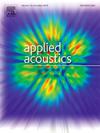Addressing aerodynamic noise in vehicles: a hybrid method for noise reduction and signal preservation
IF 3.4
2区 物理与天体物理
Q1 ACOUSTICS
引用次数: 0
Abstract
Vehicle interior noise significantly affects passenger comfort and is composed of powertrain, road, and aerodynamic noise—the latter becoming dominant at high speeds. Advances in noise control and the rise of electric vehicles have diminished engine noise, thereby accentuating aerodynamic noise, which typically spans a frequency range of 40 Hz to 5 kHz. To address the challenges posed by this broadband, nonlinear noise, we propose a Hybrid Aerodynamic Active Noise Control (HAANC) methodology that integrates advanced signal processing and machine learning for precise noise suppression. Specifically, Variational Mode Decomposition (VMD) and the Hilbert-Huang Transform (HHT) are employed for high-resolution signal decomposition and feature extraction, while an adaptive multi-filter structure enhances computational efficiency and stability. In addition, a novel signal extraction network—built on convolutional and bidirectional long short-term memory layers with an attention mechanism—is designed to preserve in-vehicle target sounds, such as conversations and music, amidst interference. Experimental evaluations on real-world datasets show that for pure aerodynamic noise signals, Normalized Mean Squared Error (NMSE) decreased by approximately 10.23 dB and the power spectral density (PSD) was reduced by an average of 15.6 dB/Hz. Under mixed-signal conditions with a –10 dB signal-to-noise ratio, short-time objective intelligibility (STOI) improved by 6.2 %, Perceptual Evaluation of Speech Quality Mean Opinion Score (PESQ MOS) increased by 26.28 %, and Mean Opinion Score Listening Overall Opinion (MOS LOO) increased by 27.42 %. These quantitative improvements substantiate the superior performance and generalization capabilities of the proposed HAANC system for enhancing passenger comfort.
求助全文
约1分钟内获得全文
求助全文
来源期刊

Applied Acoustics
物理-声学
CiteScore
7.40
自引率
11.80%
发文量
618
审稿时长
7.5 months
期刊介绍:
Since its launch in 1968, Applied Acoustics has been publishing high quality research papers providing state-of-the-art coverage of research findings for engineers and scientists involved in applications of acoustics in the widest sense.
Applied Acoustics looks not only at recent developments in the understanding of acoustics but also at ways of exploiting that understanding. The Journal aims to encourage the exchange of practical experience through publication and in so doing creates a fund of technological information that can be used for solving related problems. The presentation of information in graphical or tabular form is especially encouraged. If a report of a mathematical development is a necessary part of a paper it is important to ensure that it is there only as an integral part of a practical solution to a problem and is supported by data. Applied Acoustics encourages the exchange of practical experience in the following ways: • Complete Papers • Short Technical Notes • Review Articles; and thereby provides a wealth of technological information that can be used to solve related problems.
Manuscripts that address all fields of applications of acoustics ranging from medicine and NDT to the environment and buildings are welcome.
 求助内容:
求助内容: 应助结果提醒方式:
应助结果提醒方式:


